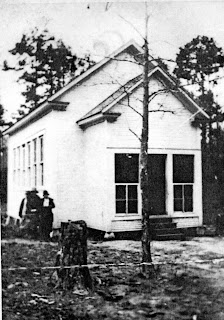 |
| Old Brushy school c 1902 Levy Winham, teacher (back left row) |
"In the late 1850's, there came settlers to a small community in Bossier Parish, now known as Brushy. These settlers, driven from their homes in the East by the Yankees and the want of more land, came from Alabama, Georgia and North and South Carolina. These, the first settlers in Brushy, were the Keiths, Childresses, Dudneys, Odoms, Mitchells, Stanleys, Sullivans, Osborns, Strayhans, Dalrymples, Marxes and Abneys.
"School in this community was taught by a single teacher in a one-room log cabin. Mr. Joe Russell, the first teacher, was followed in succession by two women, Nona Herron and Eugenia Martin.
"All of these settlers were farmers, raising corn, peas, cotton and potatoes. Some of them were homesteaders and some bought their land for from fifty cents to a dollar an acre.
"The first and only church at that time was a large Baptist Church where the school had previously stood.
"The people in those days wore clothes they had carded, spun and woven themselves, and traveled by horse, wagon or ox cart. A buggy was rarely seen and a person who owned one was considered wealthy.
"For entertainment they had accordion and fiddle playings and dances such as the Virginia Reel. Another entertainment was hunting opossums and raccoons at night with dogs. They also hunted deer at night with 'fire pans.' A 'fire pan' had a long handle with a bowl at one end. They put rich pine knots in this bowl and lighted them to make a bright light. It was put over the shoulder and light was shown into the deer's eyes, momentarily paralyzing him with fear. This unlucky animal was an important item in the died [sic] of the settler.
"Most of the settlers got water from wells, but some used springs from which they carried water, sometimes a hundred yards. The nearest store was not in Brushy, but in Collinsburg, and was owned by a Mr. Sentell.
"There are several old home sites that have not yet grown up in bushes. Most of these old sites are marked by their surroundings of crepe myrtle and bois d'arc trees. Theer [sic] is one house still standing, the old Milling house, which is over one hundred years old."
 |
| New Brushy school c 1910s |
At the Bossier Parish Libraries History Center, you can find information on pioneering families such as the Strayhans. According to records in our database, a James P. Strayhan was born in Bossier Parish in 1829 and lived as a farmer in the Brushy Community his entire life. In an oral history by Audrey Strayhan Boggs, she remembers growing up in Brushy and attending the one-room school in the early 1900s.
Visit the Bossier Parish Libraries History Center to discover more about the history of early communities and pioneering families in Bossier Parish. We are next to the Central Library branch at 2206 Beckett Street, Bossier City. Can't come in, call 318-746-7717 or email history-center@bossierlibrary.org with your request. For fun facts, photos, and videos, be sure to follow us @BPLHistoryCenter on FB, @bplhistorycenter on Tiktok.
By: Amy Robertson
No comments:
Post a Comment